

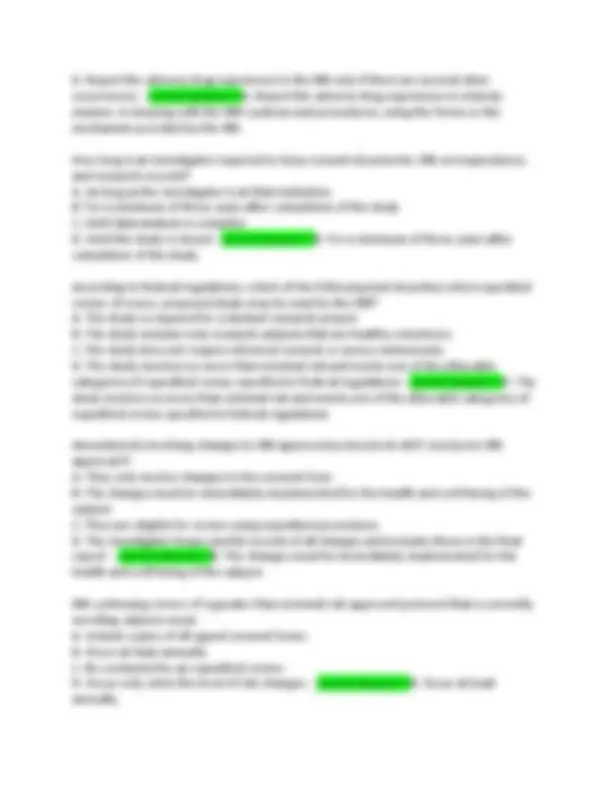


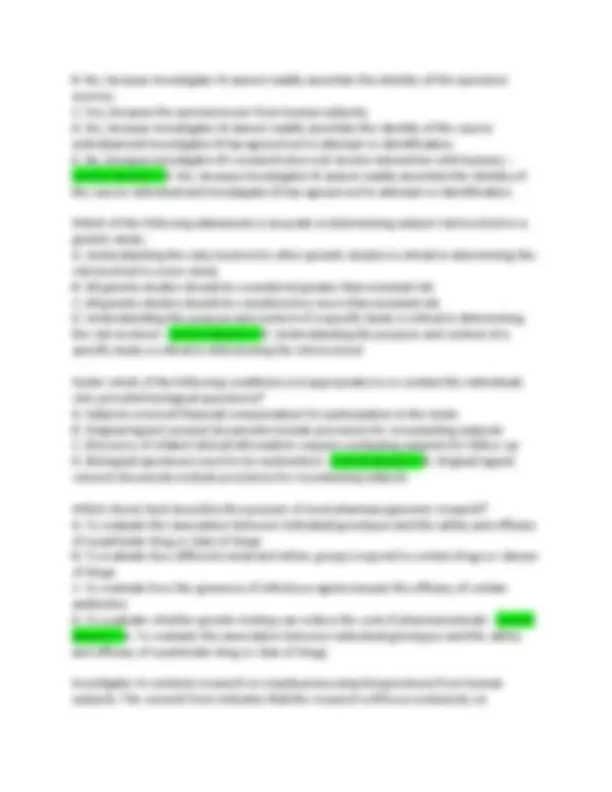


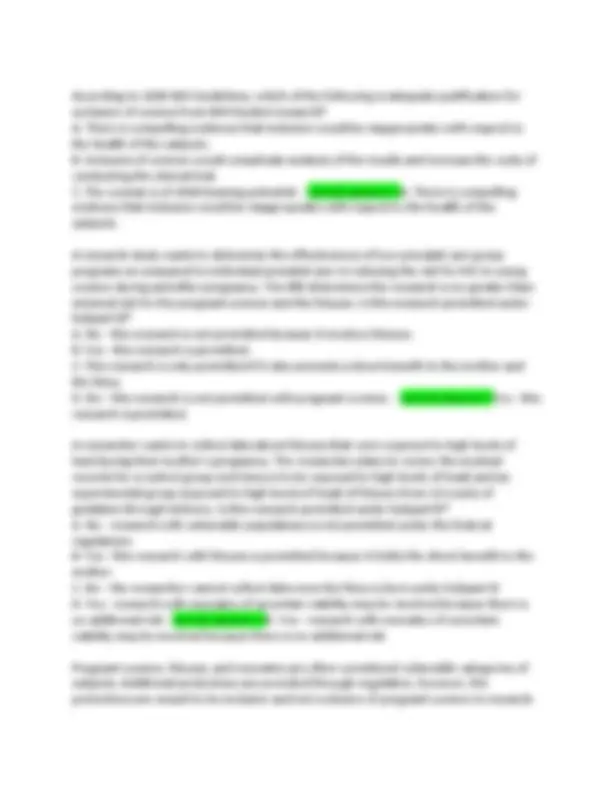



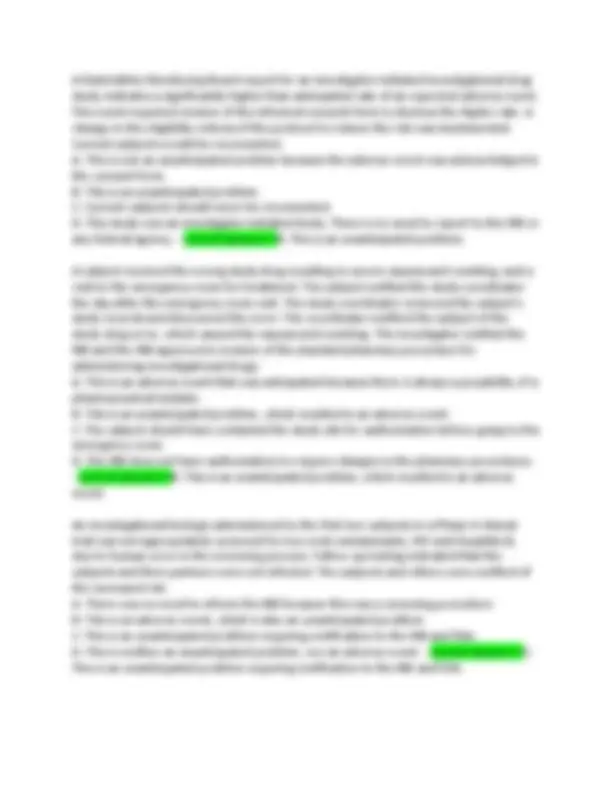

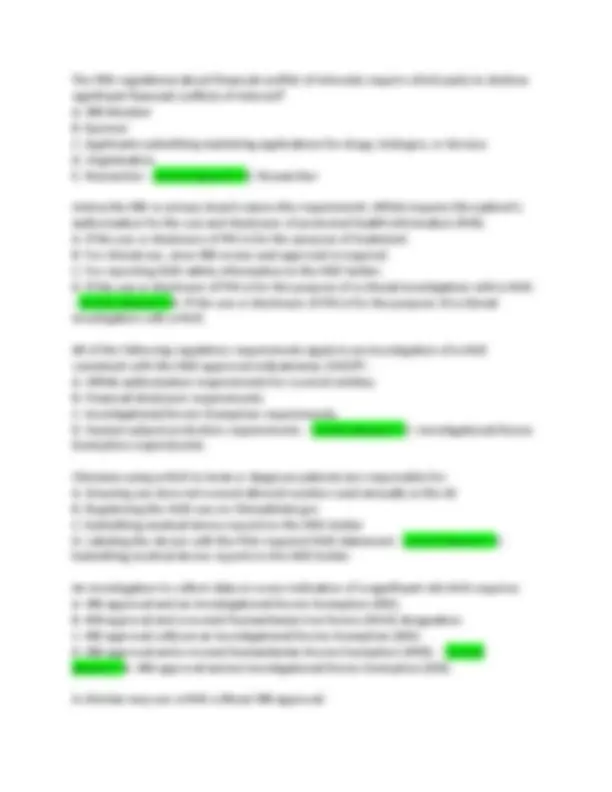
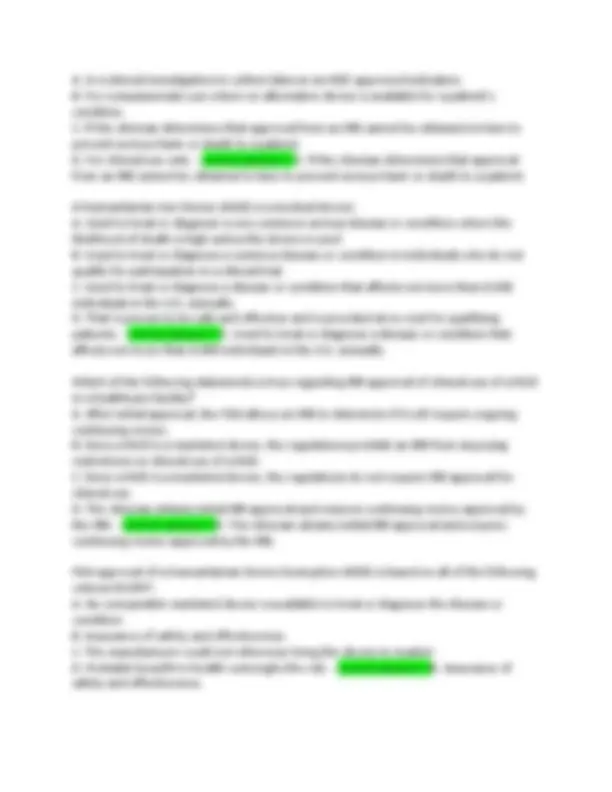
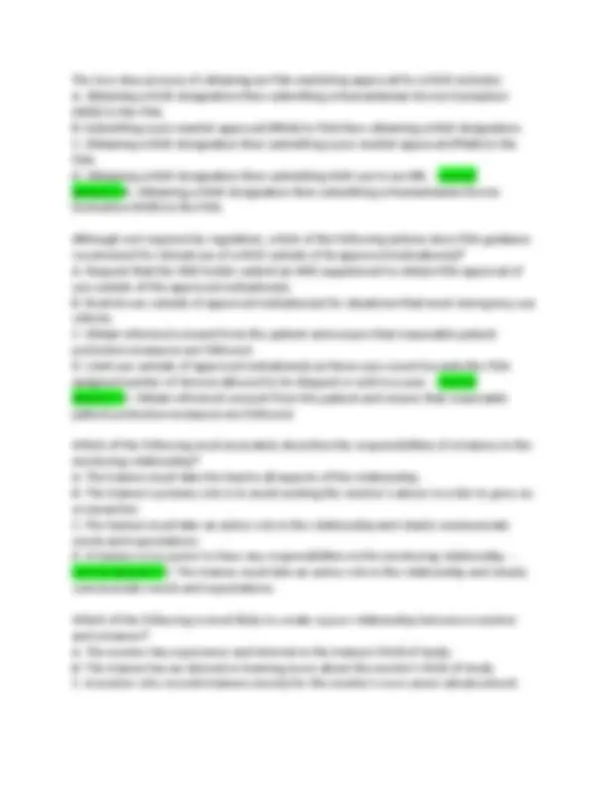

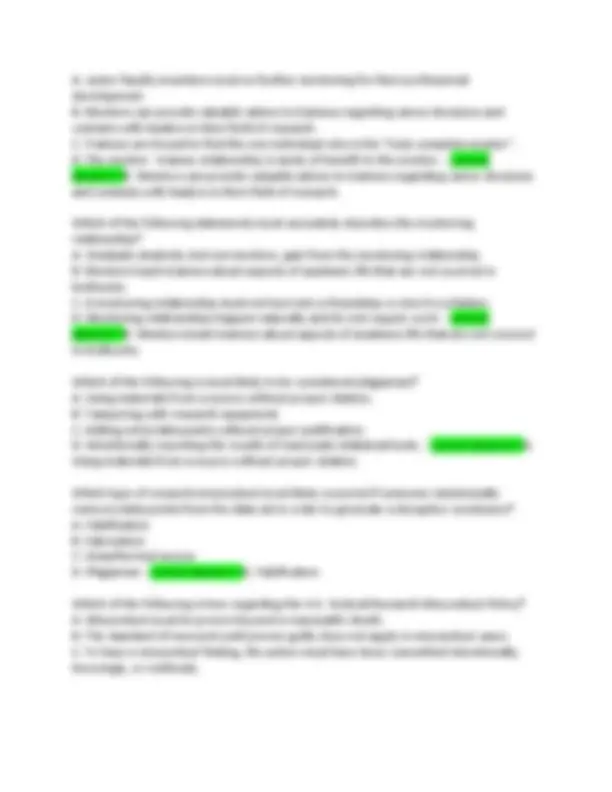

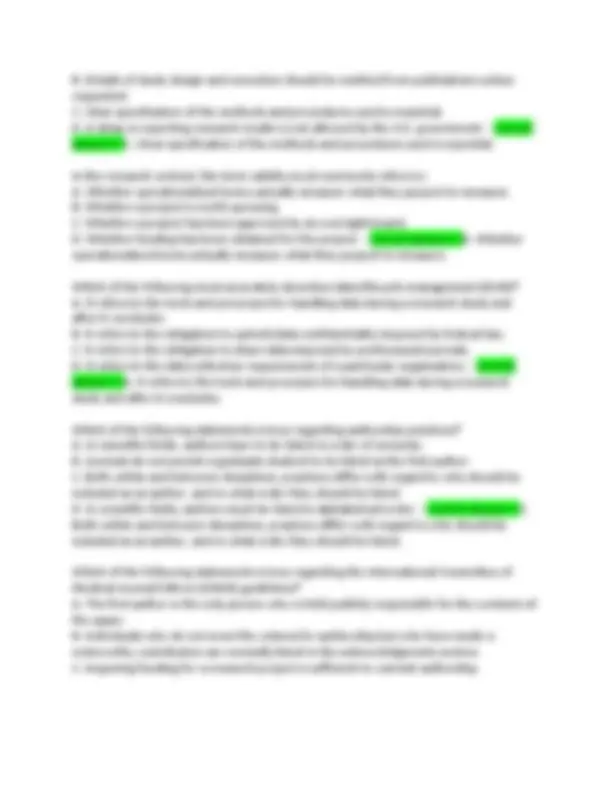

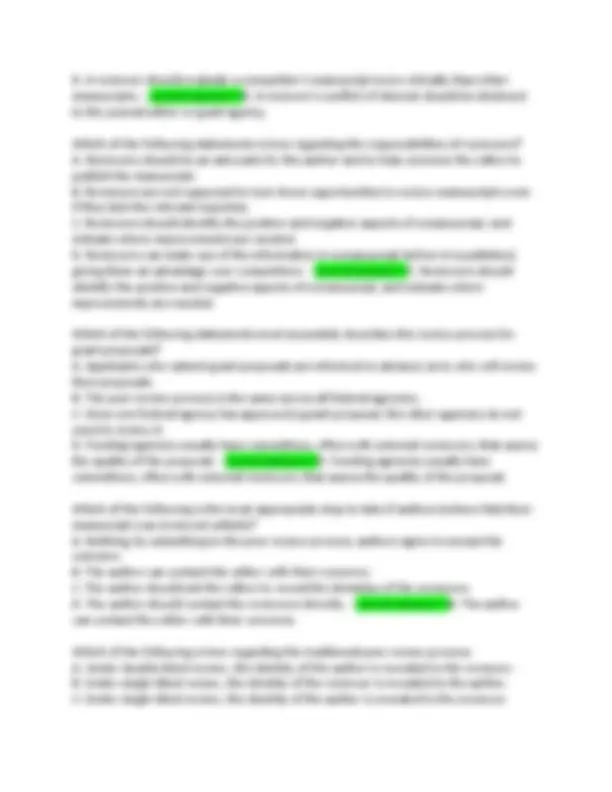
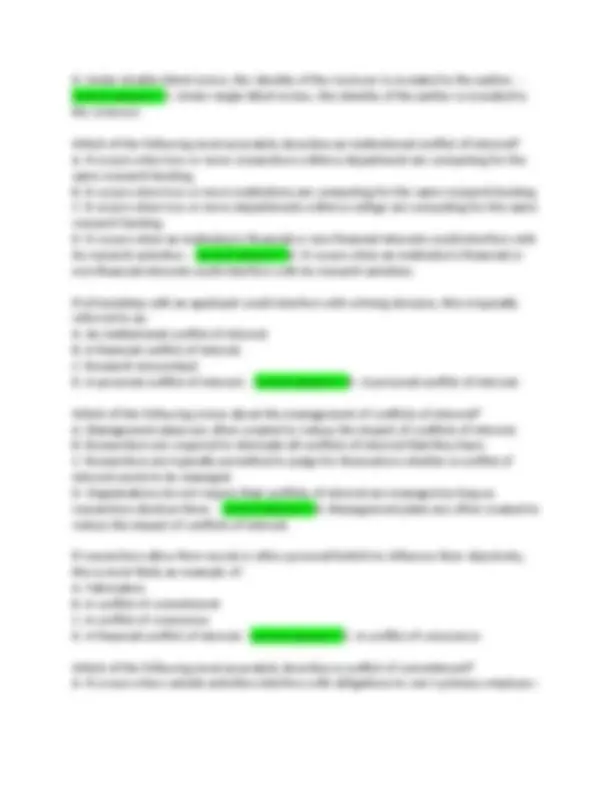





Study with the several resources on Docsity

Earn points by helping other students or get them with a premium plan


Prepare for your exams
Study with the several resources on Docsity

Earn points to download
Earn points by helping other students or get them with a premium plan
Community
Ask the community for help and clear up your study doubts
Discover the best universities in your country according to Docsity users
Free resources
Download our free guides on studying techniques, anxiety management strategies, and thesis advice from Docsity tutors
The Belmont Report's principle of respect for persons incorporates at least two ethical convictions: first, that individuals should be treated as autonomous agents, and second, that: A. Persons with diminished autonomy should only participate in no more than minimal risk research. B. Persons with diminished autonomy should be excluded from research. C. Persons with diminished autonomy are entitled to protection. D. Persons involved in research cannot financially benefit. - correct answer>>C. Persons with diminished autonomy are entitled to protection. Which of the following is an example of how the principle of beneficence can be applied to a study employing human subjects? A. Ensuring that persons with diminished autonomy are protected. B. Providing detailed information about the study and obtaining the subject's consent to participate.
Typology: Exams
1 / 34

This page cannot be seen from the preview
Don't miss anything!



























The Belmont Report's principle of respect for persons incorporates at least two ethical convictions: first, that individuals should be treated as autonomous agents, and second, that: A. Persons with diminished autonomy should only participate in no more than minimal risk research. B. Persons with diminished autonomy should be excluded from research. C. Persons with diminished autonomy are entitled to protection. D. Persons involved in research cannot financially benefit. - correct answer>>C. Persons with diminished autonomy are entitled to protection. Which of the following is an example of how the principle of beneficence can be applied to a study employing human subjects? A. Ensuring that persons with diminished autonomy are protected. B. Providing detailed information about the study and obtaining the subject's consent to participate. C. Determining that the study has a maximization of benefits and a minimization of risks. D. Ensuring that the selection of subjects includes people from all segments of the population. - correct answer>>C. Determining that the study has a maximization of benefits and a minimization of risks. Which of the following are the three principles discussed in the Belmont Report? A. IRB Review, Federal Regulations, Declaration of Helsinki B. Privacy, Confidentiality, Equitable Selection of Subjects C. Informed Consent, Institutional Assurance, Researcher Responsibility D. Respect for Persons, Beneficence, Justice - correct answer>>D. Respect for Persons, Beneficence, Justice When an IRB is reviewing a research study and they are considering if a potential subject population is vulnerable, they should consider: A. Are there adequate resources to conduct the study? B. Is there a power differential between researchers and subjects? C. Has the researcher completed required training? D. Are the research procedures greater than minimal risk of harm? - correct answer>>B. Is there a power differential between researchers and subjects?
Which is an example of a situation where deferential vulnerability might be a factor? A. An army medical officer recruiting subjects among lower ranks B. A college professor recruiting among their students C. A physician recruiting patients to be subjects D. An employer recruiting among persons who directly report to them - correct answer>>C. A physician recruiting patients to be subjects In considering NBAC's analytic approach, an otherwise competent person who is acutely ill might be considered at especially high risk of harm for: A. Economic vulnerability B. Situational cognitive vulnerability C. Capacity-related cognitive vulnerability D. Communicative vulnerability - correct answer>>B. Situational cognitive vulnerability Identify the following groups that are protected in the federal regulations (45 CFR 46), specifically in Subparts B, C, and D with additional protections: A. Pregnant women, prisoners, and mentally disabled B. Children, prisoners, and terminally ill C. Prisoners, children, and elderly D. Pregnant women, prisoners, children - correct answer>>D. Pregnant women, prisoners, children The NBAC looks at characteristics individuals might have that would prevent them from being able to provide voluntary informed consent. The traits may be thought of as falling into six broad areas: cognitive or communicative, institutional, deferential, medical, economic, and social. Prospective research subjects who are not able to comprehend information, deliberate, and make decisions about participation in a proposed research study have a: A. Institutional vulnerability B. Cognitive or communicative vulnerability C. Physical vulnerability D. Economic or social vulnerability - correct answer>>B. Cognitive or communicative vulnerability The use of prisoners in research is a concern under the Belmont principle of Justice because: A. Prisoners are less educated that the general population and have difficulty understanding research B. Prisoners may not be used to conduct research that only benefits the larger society C. Prisoners are not a representative sample of the general population
D. Report the adverse drug experience to the IRB only if there are several other occurrences. - correct answer>>A. Report the adverse drug experience in a timely manner, in keeping with the IRB's policies and procedures, using the forms or the mechanism provided by the IRB. How long is an investigator required to keep consent documents, IRB correspondence, and research records? A. As long as the investigator is at that institution B. For a minimum of three years after completion of the study C. Until data analysis is complete D. Until the study is closed - correct answer>>B. For a minimum of three years after completion of the study According to federal regulations, which of the following best describes when expedited review of a new, proposed study may be used by the IRB? A. The study is required for a student research project B. The study includes only research subjects that are healthy volunteers. C. The study does not require informed consent or survey instruments. D. The study involves no more than minimal risk and meets one of the allowable categories of expedited review specified in federal regulations - correct answer>>D. The study involves no more than minimal risk and meets one of the allowable categories of expedited review specified in federal regulations Amendments involving changes to IRB-approved protocols do NOT need prior IRB approval if: A. They only involve changes to the consent form. B. The changes must be immediately implemented for the health and well-being of the subject. C. They are eligible for review using expedited procedures. D. The investigator keeps careful records of all changes and includes them in the final report. - correct answer>>B. The changes must be immediately implemented for the health and well-being of the subject. IRB continuing review of a greater than minimal risk approved protocol that is currently enrolling subjects must: A. Include copies of all signed consent forms. B. Occur at least annually. C. Be conducted by an expedited review. D. Occur only when the level of risk changes. - correct answer>>B. Occur at least annually.
A general requirement for the informed consent form is that it may not include any exculpatory language. Exculpatory language is that which waives or appears to waive any of the subject's legal rights or releases or appears to release those conducting the research from liability for negligence. Which of the following statements in a consent form is an example of exculpatory language? A. In the event of any injury you may have related to this research, you will be given medical treatment. B. Your participation in this research is voluntary. If you choose not to participate, or change your mind later, your decision will not affect your relationship with your doctor or your right to health care or other services that you may be eligible for. C. The investigator may stop you from participating in this research without your consent if you experience side effects that make your condition worse. If you become ill during the - correct answer>>D. I waive any possibility of compensation for injuries that I may receive as a result of participation in this research. An investigator is confronted with a life-threatening situation that necessitates using a test article in a human subject who is unable to provide informed consent and there is no time to obtain consent from the individual's LAR and no alternative method or recognized therapy is available. Under the FDA regulations for using test articles, which of the following describes the best course of action for the investigator: A. Submit a research protocol to the IRB and justify an expedited review approval of the consent document so test article can be used immediately. B. Use the test article without obtaining consent from the subject or the LAR then notify the IRB. C. The investigator and an independent physician agree that the situation necessitates the use of the test article. An exception or waiver for informed consent can be made under these circumstances. The IRB will be notified later. D. Do not use the test article - correct answer>>C. The investigator and an independent physician agree that the situation necessitates the use of the test article. An exception or waiver for informed consent can be made under these circumstances. The IRB will be notified later. An elderly gentleman, whose wife is his legally authorized representative (LAR) since his strokes several years ago, was recently diagnosed with lung cancer. He is eligible for a clinical trial using a new investigational drug that aims to treat lung cancer. He is able to express interest, shows a basic understanding of the nature of the trial, and gives his assent to participation. The subject's wife is out of town on a business trip. Which of the following is the most appropriate action to take for the investigator?
A researcher is conducting a written survey about people's attitudes toward walking as an exercise option at the local shopping mall that supports a walking program. The survey is anonymous (without codes, names, or other information) and subjects may complete the survey and place it in a box at the shopping mall exits. Which of the following is the most important issue that the researcher addressed in planning the research? A. Possibility of emotional distress for subjects from the questions themselves B. Data analysis from a large sample size C. Confidentiality of the individual subject's responses D. Recruitment of subjects to ensure varied characteristics of the sample size - correct answer>>C. Confidentiality of the individual subject's responses A researcher wants to invite therapists to participate in small focus groups to discuss their perceptions regarding "troubled" adolescent girls and the relationships they have with their parents. Specific clients of the therapists will not be discussed. Which of the following will be the most important issue for the researcher to consider when planning the research? A. Amount of compensation for the subject's (therapist's) time B. Emotional distress from discussing the topic C. Recruiting strategies to ensure quick enrollment and completion of the research D. Breach of confidentiality from the focus group subjects (therapists) - correct answer>>D. Breach of confidentiality from the focus group subjects (therapists) Which of the following most accurately describes the risks associated with SBR? A. Less predictable, more variable, and less treatable than physical harms B. More likely to be treatable by researchers than physical harms C. Less serious and more frequent than physical harms D. Shorter in duration and less frequent than physical harms - correct answer>>A. Less predictable, more variable, and less treatable than physical harms Which of the following is considered a SBR data collection method? A. Blood draws B. Interviews C. Hearing/audiological screenings D. Physical exams - correct answer>>B. Interviews An investigator obtains consent and HIPAA authorization from subjects to review their medical records and HIV status. He plans to go back to the medical record, so the HIV
status information is stored along with subject identifiers in a database that he keeps on his laptop computer. His laptop is stolen. This incident constitutes: A. A FERPA violation B. An invasion of privacy C. A breach of confidentiality D. All of the above E. None of the above - correct answer>>C. A breach of confidentiality A researcher wants to conduct a secondary analysis using a Centers for Disease Control and Prevention (CDC) database that was collected by the agency solely for surveillance purposes from 1996-2006. The researcher did not participate in the initial collection of the data. The database is publicly available. The database does not include any identifiers. The IRB makes a determination that the individuals whose records will be reviewed do not meet the federal definition of human subjects. Which of the following considerations was relevant to the IRB's determination that this activity does not constitute research with human subjects? A. The researcher will not be interacting/intervening with subjects and the data has no identifiers. B. The data was collected between 1996-2006. C. The database reflects data collected originally for surveillance purposes. D. The CDC is a federal agency. - correct answer>>A. The researcher will not be interacting/intervening with subjects and the data has no identifiers. In order to grant a waiver or alteration of the requirements of informed consent, an IRB must find which of the following: A. The research involves benefit to the subjects. B. The research plan includes a data safety monitoring board. C. The research could not practicably be carried out without the waiver of consent. D. The research plan includes data from individuals no longer living. - correct answer>>C. The research could not practicably be carried out without the waiver of consent. Investigator A has biological specimens that are coded and linked to identifiers of the source individuals. Investigator A provides the specimens to Investigator B but does not provide the individual identifiers. Investigator B agrees not to re-identify the source individuals. Is Investigator B's research using the biospecimens human subjects research according to the definition of human subjects research in the federal regulations? A. Yes, because Investigator A retains the identifiers and therefore the specimens are identifiable.
emphysema. Investigator B wishes to use the biospecimens for research on lung cancer. Can Investigator B use the specimens for cancer research without re-consent if the specimens are de-identified? A. No, because it would be unethical to conduct research that is not consistent with the consent form the subjects originally signed. B. Yes, if the biospecimens are de-identified then the research is no longer considered human subjects research. C. Yes, because research with biospecimens is minimal risk. D. No, the original research subjects must be re-consented for the cancer research. - correct answer>>B. Yes, if the biospecimens are de-identified then the research is no longer considered human subjects research. Which choice is the best definition of "genetic determinism?" A. Genetic information about an individual can foster stigma and discrimination B. Genetic testing can determine appropriate treatments for certain health conditions C. Parents determine the nature of their children through the inheritance of genes D. Genes are primarily responsible for human traits, including health, behavior, and disease - correct answer>>D. Genes are primarily responsible for human traits, including health, behavior, and disease Which choice best describes the purpose of most pharmacogenomic research? A. To evaluate whether genetic testing can reduce the cost of pharmaceuticals B. To evaluate the association between individual genotypes and the safety and efficacy of a particular drug or class of drugs C. To evaluate how the genomes of infectious agents impact the efficacy of certain antibiotics D. To evaluate how different racial and ethnic groups respond to certain drugs or classes of drugs - correct answer>>B. To evaluate the association between individual genotypes and the safety and efficacy of a particular drug or class of drugs Under which of the following conditions is it appropriate to re-contact the individuals who provided biological specimens? A. Original signed consent documents include provisions for recontacting subjects B. Biological specimens need to be replenished C. Discovery of related clinical information requires contacting subjects for follow-up D. Subjects received financial compensation for participation in the study - correct answer>>A. Original signed consent documents include provisions for recontacting subjects
When conducting research that involves collecting biological specimens for genetic testing, which of the following issues is the most important for the IRB to consider? A. Need for publication of results B. Ownership of biological specimens C. Effects of findings on other family members D. Long term financial impact of results - correct answer>>C. Effects of findings on other family members Identify which types of discrimination the Genetic Information Non-Discrimination Act (GINA) protects individuals from: A. Health insurance and employment discrimination B. Disability insurance and mortgage insurance C. Gender discrimination D. Long-term care insurance and religious discrimination - correct answer>>A. Health insurance and employment discrimination The purpose of a federally supported research study is to examine the effect of scheduled cell searches on gang violence among men confined to drug treatment facilities under court order. Which of the following best describes the IRB's duties when reviewing this research? A. Because this research does not involve individual subjects who would be considered prisoners, the IRB does not have any additional duties B. Because this research involves individual subjects who would be considered prisoners and examines the possible causes, effects, and processes of incarceration, the IRB should ensure that the additional requirements for prisoner research are met C. Since this research is federally supported, the IRB does not have any duty to review this research D. Even though this research involves individual subjects who would be considered prisoners and examines an alternative to incarceration, the IRB does not have any ad - correct answer>>B. Because this research involves individual subjects who would be considered prisoners and examines the possible causes, effects, and processes of incarceration, the IRB should ensure that the additional requirements for prisoner research are met When reviewing federally supported research involving prisoners, an IRB must have which of the following, in addition to the standard requirements for IRBs to ensure that the prisoners' perspective is represented: A. Two members who are currently prison guards, wardens or parole officers B. One member who is a health care provider at the local hospital where prisoner may be treated
B. No more than minimal risk to the child. C. More than minimal risk with no prospect of direct benefit to the child. D. More than minimal risk with prospect of direct benefit to the child. - correct answer>>B. No more than minimal risk to the child. An investigator proposes a study to determine the clinical relevance of a new assay technique to measure minimal residual disease (MRD) in adolescent (age 14-16) cancer patients undergoing chemotherapy. The study requires that two additional bone marrow aspirates be performed during the course of chemotherapy. The subject's chemotherapy will not be altered based on the results of the assay technique measures. However, future patients with cancer would benefit from improved interventions based on study findings. The IRB determined that the activity was a minor increase over minimal risk. Which of the following statements best describes the IRB approval requirements for involving adolescent cancer patients in the research study? A. Assent of the child only is required. B. Assent is not required, however, both parents must give permission for the inclusion of the adolescent child. C. Assent is not required, however, one - correct answer>>D. Assent of the child and permission of both parents are required. Investigators wish to evaluate a new treatment for eclampsia (a life-threatening condition in pregnant women) in women 30 - 50 years of age. The research is intended to directly benefit the pregnant woman who is otherwise healthy and competent. The investigator must obtain consent from whom per Subpart B? A. The pregnant woman and the father of the fetus. B. The pregnant woman and her legally authorized representative. C. The father of the fetus only. D. The pregnant woman only. - correct answer>>D. The pregnant woman only. A researcher wants to examine the efficacy of mushroom extract supplementation on fetal loss, low birth weight, and severe preterm birth in healthy pregnant women. She plans to enroll women who are 12-26 weeks pregnant and randomize them to either receive the intervention or placebo until delivery. The IRB determines this intervention presents greater than minimal risk to the pregnant women subjects, and potential direct benefit to both mother and fetus. Is this research permitted under Subpart B? A. Yes - this research is permitted. B. No - this research is not permitted with pregnant women. C. Yes- This research is permitted if because it may benefit the fetuses. D. No - this research is not permitted because it involves fetuses. - correct answer>>A. Yes - this research is permitted.
According to 1994 NIH Guidelines, which of the following is adequate justification for exclusion of women from NIH-funded research? A. There is compelling evidence that inclusion would be inappropriate with respect to the health of the subjects. B. Inclusion of women would complicate analysis of the results and increase the costs of conducting the clinical trial. C. The woman is of child-bearing potential. - correct answer>>A. There is compelling evidence that inclusion would be inappropriate with respect to the health of the subjects. A research study wants to determine the effectiveness of two prenatal care group programs as compared to individual prenatal care in reducing the risk for HIV in young women during and after pregnancy. The IRB determines the research is no greater than minimal risk for the pregnant women and the fetuses. Is this research permitted under Subpart B? A. No - this research is not permitted because it involves fetuses. B. Yes - this research is permitted. C. This research is only permitted if it also presents a direct benefit to the mother and the fetus. D. No - this research is not permitted with pregnant women. - correct answer>>Yes - this research is permitted. A researcher wants to collect data about fetuses that were exposed to high levels of lead during their mother's pregnancy. The researcher plans to review the medical records for a control group (not known to be exposed to high levels of lead) and an experimental group (exposed to high levels of lead) of fetuses from 12 weeks of gestation through delivery. Is this research permitted under Subpart B? A. No - research with vulnerable populations is not permitted under the federal regulations B. Yes - this research with fetuses is permitted because it holds the direct benefit to the mother C. No - the researcher cannot collect data once the fetus is born under Subpart B D. Yes - research with neonates of uncertain viability may be involved because there is no additional risk - correct answer>>D. Yes - research with neonates of uncertain viability may be involved because there is no additional risk Pregnant women, fetuses, and neonates are often considered vulnerable categories of subjects. Additional protections are provided through regulation, however, the protections are meant to be inclusive and not exclusive of pregnant women in research.
A sponsor proposes research to evaluate reengineering a commercially available pacemaker. It is hoped that the new pacemaker will pose fewer risks to individuals when compared to the current commercially available product. How should this device be classified? A. Significant risk device B. Non-significant risk device - correct answer>>A. Significant risk device An adult with attention deficit hyperactivity disorder (ADHD) presents to a physician. To date, no behavioral or drug interventions have proven useful. The physician has just read several reports about a drug that is approved and marketed for another indication, but has shown some benefit for ADHD. The physician wants to prescribe this drug, in the labeled marketed dose, for the individual patient. Which of the following would be the most appropriate course of action? A. Treat the patient with the drug based on physician's best medical judgment B. Submit an Investigational New Drug (IND) application before treating the subject C. Submit a research protocol for IRB review and approval before treating the patient D. Inform the patient that the drug cannot be prescribed - correct answer>>A. Treat the patient with the drug based on physician's best medical judgment An investigator proposes to study a marketed product sold to treat high blood pressure in individuals over age 12 using a liquid formulation for children under age 12. The drug sponsor hopes that the information from the research can be used to change the labeling for use of the drug in younger children. Which of the following is the investigator's most appropriate course of action? A. Submit an Investigational Device Exemption (IDE) application to the FDA B. Submit the research protocol to the IRB for review and submit an IND application to the FDA before conducting the research C. Submit the research protocol to the Office for Human Research Protections (OHRP) for their review D. Submit the research protocol to the IRB for review, but do not submit an IND application to the FDA since the drug is already approved and marketed for this indication - correct answer>>B. Submit the research protocol to the IRB for review and submit an IND application to the FDA before conducting the research The FDA's regulations related to electronic records and electronic signatures (21 CFR Part 11) are intended to: A. Require use of electronic records for all drug research. B. Prohibit the use of paper printouts of electronic records. C. Allow the use of electronic documents and signatures in the regulatory process for drugs and devices.
D. Provide specific standards for the informed consent process. - correct answer>>C. Allow the use of electronic documents and signatures in the regulatory process for drugs and devices. An academic medical center is selecting a new database system for clinical research. The system needs to be "Part 11 compliant" in order to allow: A. The database system to assign passwords. B. The investigator to email subjects about the research. C. The medical center to replace the use of paper records with electronic records for its research. D. The use of paper records meeting FDA requirements. - correct answer>>C. The medical center to replace the use of paper records with HIPAA includes in its definition of "research," activities related to: A. Population health. B. Anything a researcher does in a federally-supported laboratory. C. Quality assessment and improvement. D. Development of generalizable knowledge. - correct answer>>D. Development of generalizable knowledge. The HIPAA "minimum necessary" standard applies... A. To all human subjects research. B. To all human subjects research that uses PHI without an authorization from the data subject. C. To all human subjects research that uses PHI. D. To all research where the data crosses state lines. - correct answer>>B. To all human subjects research that uses PHI without an authorization from the data subject. HIPAA's protections for health information used for research purposes... A. Replace those of the Common Rule and FDA for human subjects protection. B. Only apply to research conducted inside covered entities. C. May be used at the institution's discretion instead of the Common Rule and FDA protections. D. Supplement those of the Common Rule and FDA. - correct answer>>D. Supplement those of the Common Rule and FDA. A HIPAA authorization has which of the following characteristics: A. Cannot be revoked by the data subject. B. Cannot be combined with any other document related to the research. C. Is provided at the investigator's discretion.
B. If personal identifiers will be retained and used in the data analysis. C. How the data will be collected and secured. D. Who will have access to the data. E. All of the above - correct answer>>E. All of the above When a research project includes the collection of biological samples, all planned future uses of the samples, identifiers, and the data obtained from the samples, must be fully explained to the research subject. A. True B. False - correct answer>>A. True A study requires that each subject be given two study drugs. The first study drug is given on Day 1. A second study drug is given on Day 7 to counteract the toxicity of Drug 1. Subject # 4-706 is given Drug 1 on Day 1. Due to a snowstorm, Subject 4-706 is delayed for several days before returning to the site for Drug 2. Missing the administration of Drug 2 on Day 7 placed the subject at risk of significant toxicity. This event required the subject be notified of the increased risk and required close monitoring of the subject by phone. A. This is not an unanticipated problem because adverse weather is a possibility in the area where the site is located. B. This is not an unanticipated problem because the subject was required to return on Day 7. C. This is an unanticipated problem that does not include an adverse event. D. This is an adverse event, which does not require notification to the IRB. - correct answer>>C. This is an unanticipated problem that does not include an adverse event. Housekeeping employees of the medical center were recruited for a federally funded study of blood pressure, blood count levels, infectious disease history, and job stress. The interviews and blood tests were conducted in a private location not affiliated with the study center. Follow-up interviews were conducted in the same location. The study coordinator stopped at the cafeteria on her way back to the study office after the second study visit for the last three study subjects and lost the three file folders. Records of one subject indicated he had a history of a sexually transmitted disease and another had recently been treated for tuberculosis. The subjects were notified of the loss. Following this event, the IRB approved a protocol change requiring that all records be transmitted electronically to the study office using the medical center's secure network. A. This is not an unanticipated problem because employees' - correct answer>>C. This is an unanticipated problem and not an adverse event.
A Data Safety Monitoring Board report for an investigator-initiated investigational drug study indicates a significantly higher than anticipated rate of an expected adverse event. This event required revision of the informed consent form to disclose the higher rate. A change in the eligibility criteria of the protocol to reduce the risk was implemented. Current subjects would be reconsented. A. This is not an unanticipated problem because the adverse event was acknowledged in the consent form. B. This is an unanticipated problem. C. Current subjects should never be reconsented. D. This study was an investigator-initiated study. There is no need to report to the IRB or any federal agency. - correct answer>>B. This is an unanticipated problem. A subject received the wrong study drug resulting in severe nausea and vomiting, and a visit to the emergency room for treatment. The subject notified the study coordinator the day after the emergency room visit. The study coordinator reviewed the subject's study records and discovered the error. The coordinator notified the subject of the study drug error, which caused the nausea and vomiting. The investigator notified the IRB and the IRB approved a revision of the standard pharmacy procedure for administering investigational drugs. A. This is an adverse event that was anticipated because there is always a possibility of a pharmaceutical mistake. B. This is an unanticipated problem, which resulted in an adverse event. C. The subject should have contacted the study site for authorization before going to the emergency room. D. The IRB does not have authorization to require changes in the pharmacy procedures.